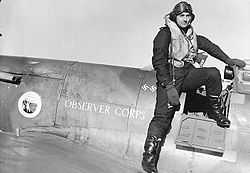Don Finlay
 Squadron Leader Don Finlay on his Spitfire IIA, 41 Squadron, RAF Hornchurch, November 1940 | ||
| Medal record | ||
|---|---|---|
| Men's athletics | ||
| Competitor for | ||
| Olympic Games | ||
| Silver | 1936 Berlin | 110 m hurdles |
| Bronze | 1932 Los Angeles | 110 m hurdles |
| European Championships | ||
| Gold | 1938 Paris | 110 m hurdles |
| British Empire Games | ||
| Competitor for | ||
| Gold | 1934 London | 120 yd hurdles |
Group Captain Donald "Don" Osborne Finlay, DFC, AFC (27 May 1909 — 18 April 1970) was a British athlete and Royal Air Force officer. He was born in Christchurch, Hampshire and died in Great Missenden.
Athletics career
A member of Milocarian Athletic Club and Surrey Athletics Club ( based in Kingston upon Thames), he represented Great Britain in three Olympics both pre- and post-World War II.In 16 international dual meets, Finlay only lost two hurdles races: to Lord Burghley in 1931 (vs. Italy) and to John Thornton in 1937 (vs. Germany).
He first competed in the 1932 Summer Olympics held in Los Angeles, United States in the 110 metre hurdles where he won the bronze medal. He was also a member of the British relay team which finished sixth in the 4×100 metre relay event. He returned to the 1936 Summer Olympics held in Berlin, Germany where he improved to win the silver medal in the 110 metre hurdles.[1] With the British relay team he was eliminated in the first round of the 4×100 metre relay competition.
He was the British Team Captain in the 1948 Summer Olympics in London and was chosen to take the Olympic Oath,[2] though he failed to win any medals in these Games when he was eliminated in the first round of the 110 metre hurdles event, hitting the last hurdle with his leading foot and falling at the finish.[3] In 1949, at the age of 40, he won his eighth AAA title and he was the AAA indoor champion in both 1937 and 1938.
At the 1934 Empire Games he won the gold medal in the 120 yards hurdles competition. He also participated in the 1950 British Empire Games and finished fifth in the 120 yards hurdles contest.
He was the Inter-Services champion in the long jump and was RAF champion in the high jump.
Military career
He joined the RAF in April 1935, and was posted to No 17 Squadron, and later in 1936 to No. 54 Squadron RAF before attending the RAF School of Aeronautical Engineering at Henlow.
In World War II he was posted to fly Spitfires as commanding officer of his old 54 Squadron, then based at Hornchurch, on 26 August 1940, during the Battle of Britain. He was shot down over Ramsgate two days later and was wounded. Afer recovering he was posted to command No. 41 Squadron in September. He claimed his first victory, a Messerschmitt Bf 109, over the Channel on 23 September, and by the end of October 1940 he was credited with a 'share' in a second Bf 109 and a Dornier Do 17 bomber, and had also damaged a further three Bf 109s. His aircraft was damaged in combat with Oblt. Hans-Ekkehard Bob of JG 54 on 9 October 1940. He added two more Bf 109s to his tally on 23 and 27 November 1940.
He was promoted to the rank of Wing Commander in August 1941, becoming 11 Group Engineering Officer. He received the DFC in June 1942. His victory tally flying fighters was 4 and 2 shared destroyed, 3 and 1 shared damaged.[4]
He then commanded No. 608 Squadron RAF, flying Lockheed Hudsons in the Middle East from December 1943 to July 1944. He became a Group captain and was posted as SASO, 210 Group. In 1945 he then commanded 906 Wing in Burma, being awarded an AFC in September 1944.
As a Group Captain he was posted to No. 1 School of Technical Training, RAF Halton, as Senior Technical Training Officer. He regularly took part in the station sports meeting and even at the age of 43 won every event he entered: 100x Hurdles, 100x, 220x, High Jump and the Long Jump. He entered the Veterans'(over 40) Handicap. He took the offered three yard start in full running kit, unlike all the other entrants who were in shirts and rolled-up trousers. From the start he raced to the tape, to show that he could've won if he wanted to. He then stopped, turned round and started to run back down the track. In doing so he knocked over a few of the real competitors who were close behind. Loud boos rang around the athletic track and all respect was lost for someone who, on his arrival at Halton had been almost 'hero-worshipped'.[citation needed]
He was stationed for much of his time at RAF Acklington, whose chapel contains a recently dedicated stained glass window to honour him.
He retired from the RAF in February 1959. He was severely injured and paralysed in a motor vehicle accident in 1966, which led to his death on 19 April 1970, aged sixty.
In 2012 No 41(R) Squadron based at RAF Coningsby unveiled a Panavia Tornado GR4 ZA614 "EB-Z" with special tail markings celebrating Don Finlay's command of the Squadron and his achievements in the 1932 and 1936 Games.[5]
References
Bibliography
- Price, Alfred. (1996). Spitfire Mark I/II Aces 1939-41. London: Osprey Aerospace. ISBN 1-8553-2627-2 or ISBN 978-1-8553-2627-9
External links
| Wikimedia Commons has media related to Don Finlay. |
| |||||
| ||||||||